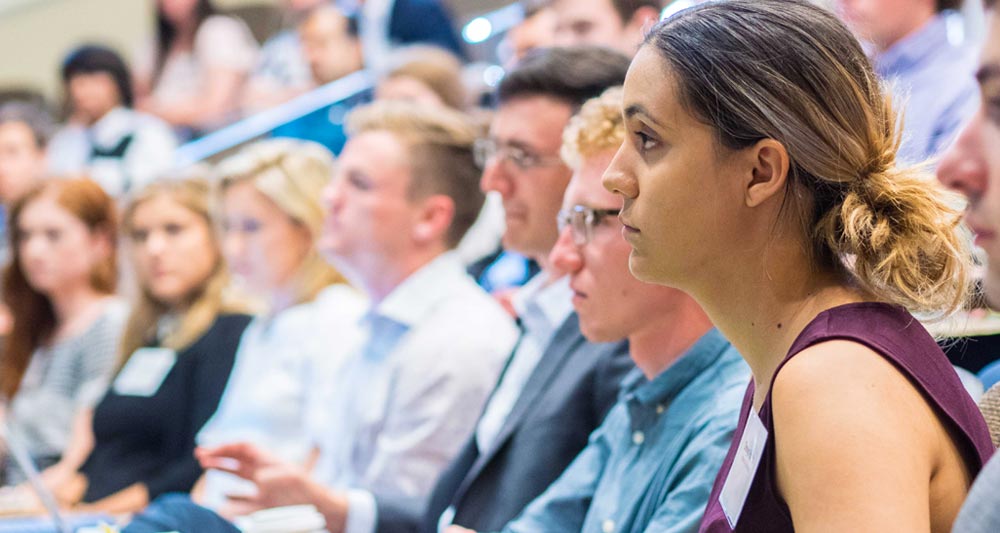Blazing a Path to Excellence, Professionalism, Innovation, Collegiality

September 19, 2019 | By Brian Fugate
Infusing a culture of continuous improvement into an organization is often met with roadblocks. Five common obstacles stand out as especially challenging: employee resistance, assuming what the customer values, jumping to solutions, solutions driven by technology, and decaying improvements. However, in a recent process improvement effort in the Sam M. Walton College of Business, I witnessed the opposite.
In our supply chain process improvement course, students worked collaboratively with the advising center to improve student advising in the business college. Advisers help students make thoughtful decisions related to their academic experience and maximize their educational and career opportunities. It consists of twelve advisers who meet with students in more than 18,000 advising appointments each year.
The objective was for the advising center to address student success “one student at a time.” As Chancellor Joseph Steinmetz has stated, “In short, student-centeredness should permeate everything we do and guide every decision we take. It should motivate us to continuously ask ourselves what can be improved and compel us to share those thoughts with each other.”
To that end, this video provides some highlights of the improvement effort in Walton College advising.
What you don’t see in the video are the many challenges we ran into along the way. More interestingly, the video doesn’t highlight the unexpected experiences of the effort. Here are five counter-intuitive experiences I observed during the effort, followed by possible reasons for the positive outcomes.
1. Participant Engagement Over Resistance
Ask just about any expert what the single biggest barrier to starting process improvement is and they’ll answer: employee resistance. Having experienced employee pushback – from common skepticism to screaming expletives, employees quitting on the spot, and even personal death threats – during industry experience and consulting projects, I was prepared for an onslaught of resistance. Certainly, the advisers and advising directors felt a little uncomfortable (a good sign, as it is necessary for learning). Yet they did not resist with the typical “don’t touch my stuff” or excuses such as “let’s wait because we are currently changing our process.” Instead, they were passionate about finding ways to make their job better so they could better serve students. For instance, one student commented in her reflection paper:
“You (Professor Fugate) cautioned us about people pushing back when trying to make changes to any process. But I really liked how the advisers we worked with were always willing to meet with us and were receptive to our ideas. They questioned us a lot, but they cared about improving too.”
Not only did the advisers accept the challenge, they dove head-first into the journey, excited about the creative ideas from students, and even pushed the effort forward on a consistent basis.
2. Co-creation of Customer Value Over Analyzing From a Distance
A foundational, first principle of process improvement (or any supply chain management effort) is to start with the customer; to deeply understand what the customer values. Unfortunately, process improvement often proceeds with a shallow understanding of the customer. And many who make an effort to understand the customer conduct their analysis from a distance. Managers sit in a room evaluating industry benchmarks, customer surveys, and recorded complaints. Perhaps they create customer empathy maps of what they perceive the customer is thinking, saying, feeling, and doing. These are important and helpful activities, but the problem arises because the customer is not in the room while they define what the customer values.
The advising process improvement effort had the unique benefit of students—the customers—being directly involved. While the students in the course captured data and insights from the broader business student population, they also had first-hand experience of what the students (customers) actually valued from the advising process. The “customers” then engaged collaboratively during the design, experiments, and implementation of the process improvements. Their experience proved invaluable.
While setting up the course, I had visited with the advising center prior to the start of the semester in order to scope the project for the students. I learned that with only 12 advisers handling over 18,000 appointments per year, the lead-time for students to get appointments was longer than ideal. Based on those early discussions, I assumed that the problem we would try to solve centered around reducing the length of each appointment time. Doing so would allow each adviser to see more students per day, and thus reduce the scheduling lead-time for students.
The students (and advisers) quickly challenged my assumption. Experiencing student-life and the need for advising in real-time, they understood what the students valued most was the thoughtful back-and-forth discussions related to students’ academic experience as a whole in order to maximize their educational and career opportunities. Of note is that we later found out that this is what the advisers valued most as well; not herding students through the advising process like widgets.
One student highlighted the importance of this co-creation of value in his reflection paper:
“At the start of the Walton student advising process improvement project, before even making the current process flow map, we put ourselves in the shoes of students and tried to understand their perspective of the advising process and identify ways they are dissatisfied with the current structure. This established our mindset for the rest of the semester, and while a some of our initiatives were for making advisers’ jobs better, ultimately all of the recommendations were for the benefit of the students.”
3. Problem Solving Over Jumping To Solutions
Another common obstacle in continuous improvement efforts is the tendency to instantly hunt for solutions without first deeply understanding the current situation. Making plausible but unfounded assumptions to implement solutions quickly is human nature (at least after childhood). Initially, the students were no exception. Yet, after shifting their mindset and practicing the logic and method for how to proceed through unclear territory of the improvement effort, the students transitioned to true problem-solving approaches much faster and easier than I typically observe in organizations.
For instance, following the Improvement Kata model (a problem-solving routine, see Mike Rother’s Toyota Kata) we held regular coaching sessions to deliberately practice pragmatic scientific thinking. This involved rapid cycles of Doing—Feedback—Adjustment (or Plan-Do-Check-Act via A3s if you are familiar with lean).
I found myself defaulting, somewhat hypocritically, to leading the students to solutions during our early Kata coaching sessions. The students would then try to force-fit solutions that were at best temporary fixes. After the advisers pointed out the flaws in our initial proposed solutions, the sessions were refocused to ask the right questions. The students then began uncovering root causes and understanding the current situation so deeply that the best solutions became obvious.
Based on my incorrect assumptions, I had guided the students to focus on eliminating non-value-added activity within the advising sessions to shorten each appointment. Our solutions would have reduced interaction between the adviser and the student and prevented the sharing of vital information such as FAQs, revising online scheduling templates, and requiring students to complete these prior to appointments.
Early feedback from advisers and deeper root cause analyses made it clear that solutions focused only on efficiency were not appropriate. The students and advisers subsequently developed and tested solutions that would increase opportunities to discuss each student’s career and life aspirations. Advisers could then offer more guidance on planning (including course scheduling) and opportunities that align with the student’s unique situation, such as international study abroad, leadership development, student clubs, non-traditional course and program scheduling paths, and the many other student-centered programs within the Walton College and university.
4. People and Process Over Technology
One solution that we commonly jump to is technology. I expected the students to do the same. I was surprised, however, that they soon learned to first consider the people and process based on what the customer values and then use technology to enable people and processes, not the other way around. For instance, one student stated in her reflection paper:
“my mindset for fixing any problem was, ‘automate it.’ I figured that by speeding up the current process with automation or improved software, all of the problems would be solved. However, after the advising process mapping process, I realized that many of the defects were not from a lack of speed or inaccuracy from manual labor, but rather from underlying systematic flaws that could not be fixed with technology alone.”
Some of the solutions still involved automation and technology to remove non-value-added activities. I was surprised that most of the solutions were paper-based and involved revising and resequencing of steps in the appointment process. Instead of the efficiency-focused solutions of reducing time to flow students through the advising center in order to process more students per day, solutions were tested and implemented that were simple, tangible, visible, and in some cases high-touch that enabled more of what the students (and advisers) valued most.
5. Continuous Improvement Over ‘One and Done’
Research discussed in a 2018 Harvard Business Review article, "Making Process Improvement Stick: Early Excitement Usually Leads to Backsliding,” revealed that almost half of the projects in the study did not continue to improve a year after launch. A recent survey from goleansixsigma.com found that managers’ least favorite phase of the process Six Sigma improvement methodology is “control.” This is the phase that involves building structures to sustain continued improvements. Many a lean kaizen event often creates excitement and early successes, but more often than not the progress tends to slip and decay over time. Entropy – the second law of thermodynamics –begins eroding the gains that have been made. Employees slip back into their regular routine and/or are pulled into the next new hot topic.
While we are still early in our process improvement journey, I’ve been surprised to see continued improvements occur both within the advising center and the college. The advisers regularly meet to review advising data (process and outcome metrics, autotomized notes from advising meetings, etc.), identify abnormalities in the processes, problem-solve, and learn. In talking with the advising center directors and several advisers, it seems to me that they’ve been bitten by the process improvement bug. Just as importantly, after sharing the experience of the advising process improvement effort throughout the college, other efforts have been initiated in areas such as employee onboarding, accounting, and recruitment. I’m optimistic and I see strong signs that that process improvement will continue to spread throughout the college, affecting the organizational culture—how we think and behave.

Why The Unexpected Experiences During This Improvement Effort?
Perhaps part of the unexpected experiences during this effort is simply situational. Many of the challenges we experience stem from organizations that have poorly (efficiency-driven waste removal program) understood “lean,” “Six Sigma,” or other approach that left scars of frustration and failure. Employees who have suffered through these initiatives balk with a “here we go again,” don’t fully engage, and look for quick solutions in order to get back to their daily responsibilities. In our situation, we were fortunate that we were starting this continuous improvement journey relatively fresh, with few individuals marred with earlier negative preconceived notions (except me, obviously).
But I believe the main reasons for the unexpected experiences of the process improvement effort can be boiled down to leadership who:
- fully participated in the effort
- aligned the effort with the purpose, passion, and values of the college and university.
Too often, leadership adopts a “management by objectives” style that abdicates to others the task of “going and seeing the work” to understand the real situation. As lean expert, Jeffrey Liker, points out, if the leaders and coaches do not have a firsthand grasp of the situation, they cannot lead. The college and advising leadership—the college dean team (Anne O’Leary-Kelly, Alan Ellstrand, and Matt Waller) and directors in the advising office (Jeff Hood and Autumn Parker)— fully collaborated in the process. They started with a strong foundation of process improvement thinking by going through lean training with Simmons Foods (Simmons has trained thousands of employees and community members in Lean rules and principles). While one cannot fully grasp process thinking during training sessions, this provided a solid basis and philosophy for improvement. The effort benefited from additional help from continuous improvement consultant, Neal Dellett. Then, the leadership participated throughout the effort by engaging with the students in class, helping in data collection, and coaching during analysis, proposals, and experiments.
In addition, the research in the previously mentioned 2018 Harvard Business Review article suggests that visible support from senior leadership was the key to making and sustaining improvements successfully. The conditions of the student advising process improvement effort reinforces those findings. At the outset and repeatedly throughout the effort, our leadership provided a clear narrative about the alignment of the improvement effort with the college and university purpose and values.
This alignment was critical to the success of the improvement effort. First, the effort directly supported a clear purpose of the University of Arkansas- advancing student success. Second, it aligned with the college vision of being a “…catalyst for transforming lives in Arkansas, the United States and the world.” Correspondingly, the effort aligned with an area in which the participants (advisers and students) had a passion and had been experiencing real pain points. Doing so enabled a natural motivation for the advisers and students to engage in the effort. Finally, the culture of the advising office has a long history of being steeped in our Walton College EPIC values—Excellence, Professionalism, Innovation, and Collegiality. In other words, those in the advising office have a passion for helping students succeed, grounded in values that support continuous improvement.

